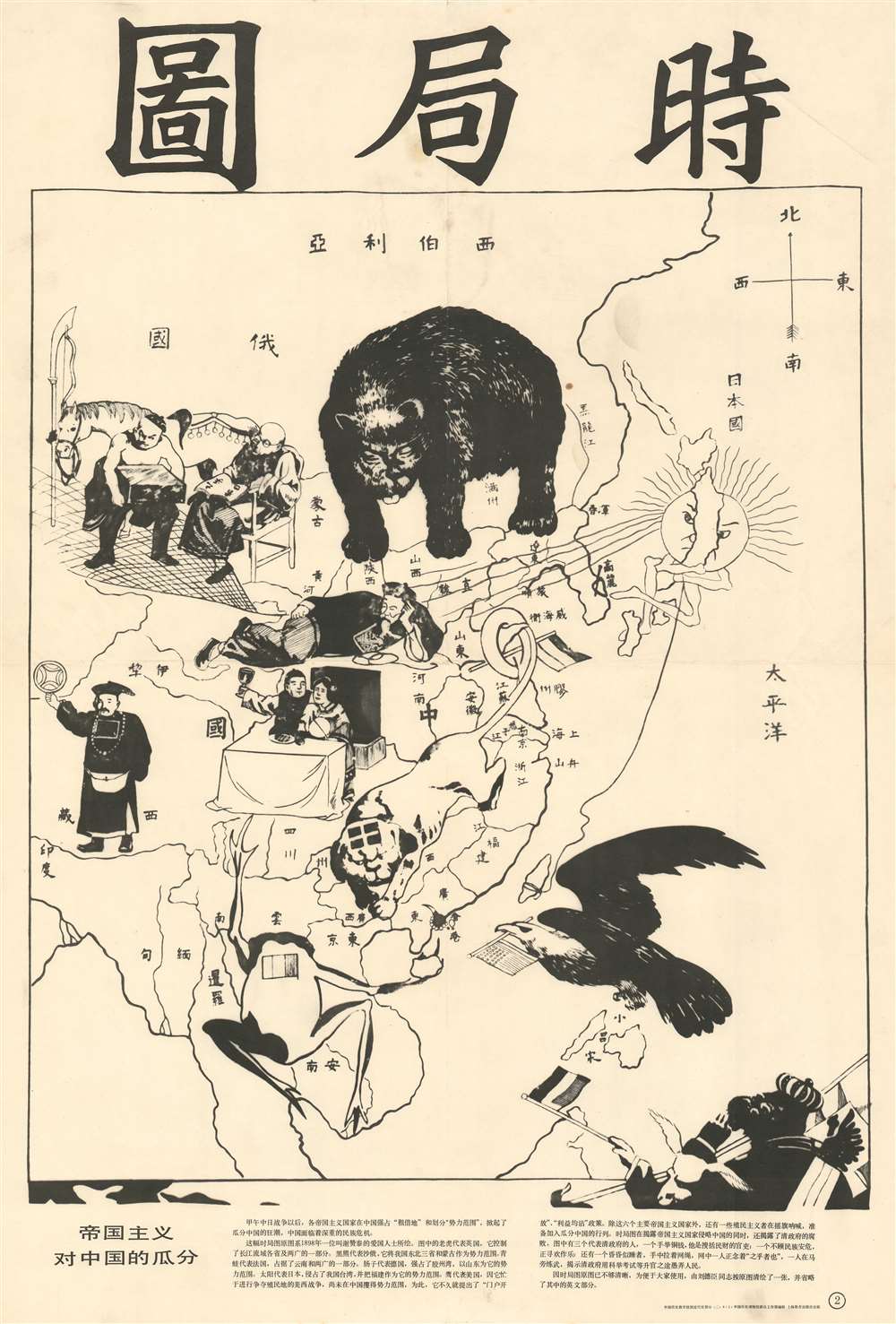This item has been sold, but you can get on the Waitlist to be notified if another example becomes available, or purchase a digital scan.
1950 Xie Zuantai Communist Propaganda Serio-Comic Map of China
ChinaSerioComic-xiezuantai-1950
Title
1950 (undated) 30 x 20.25 in (76.2 x 51.435 cm)
Description
From Anti-Qing to Communist Propaganda
This image was originally complied in 1898 by Xie Zuantai (謝纘泰, 1872 - 1939), a member of Sun Yat-Sen's Revive China Society and published in Hong Kong. The original map, which also included English subtitles, went through several editions and states, with at least one chromolithograph variant issued in Japan, with Xie Zuantai's permission, in 1899. An example of this version made its way to the U.S. Library of Congress where around 1940 it was rediscovered by Zhu Shijia (朱士嘉). Shia took the map to China, where Communist political officials became enamored of it, co-opting the image for propaganda purposes. The present version was revised by the Chinese official Liu Dechen, who simplified the graphic and removed the, as far as he was concerned, superfluous English captions. Although originally conceived as a reaction to the First Sino-Japanese War (1894 - 1895), colonial expansion beyond the Treaty Ports, and a criticism of the weak Qing administration, the Communists found it equally apt to their own political message.Understanding the Map
Xie Zuantai employs Fred Rose style imagery to illustrate the threats and menaces to China, both internal and external. The external threats are clear. At center a bulldog, here re-envisioned as a lion, represented England and British control of the Yangtze Valley and Shanghai. The bear, Russia, threatens from the north, expanding into the northeastern Chinese provinces and Mongolia. Form the south, a frog represents France, who through French Indochina, had influence in Yunnan and southeastern China. Japan is represented by the sun, with rays of influence extending into Manchuria and a leash on Taiwan (which the Chinese saw as part of Fujian). The United States, represented as an Eagle, is in the Philippines - although by the time this map was issued the American colonial period in the Philippines had come to an end.Internal threats to China are also illustrated. While these images were initially criticisms of the weak Qing administration, in the present example, this imagery has been co-opted to apply to all pre-Communist regimes. An image over Tibet illustrates a Qing official holding aloft a bronze coin - suggestive of ripping off the people. At center, a couple dines in luxurious surroundings - suggestive of Qing obsession with carnal delights. Just above, another Qing official sleeps - a reference to China's Opium problems. A fourth image, in the upper left, details a warrior and a scholar, criticizing the historical Qing exam system that called for potential officials to demonstrate both physical and intellectual prowess.
The text below the map explains much of the above, but also criticizes the American 'Open Door Policy'. 'Open Door' (门户开放) refers to the U.S. policy established in the late 19th century active through the early 20th century that called for all nations to trade with China on equal terms. Under this policy none would have exclusive trading rights in a specific area or over a specific commodity. While this policy did, in theory, prevent further Colonial expansion into China, it also, in effect, undermined Chinese sovereignty. The government of the Republic of China endeavored to revise related treaties with foreign powers in the twenties and thirties. Only after the conclusion of World War II and the rise of Mao did China manage to regain its full sovereignty.
Publication History and Census
This map was redesigned to Communist ends by Liu Dechen (刘德臣) published in Shanghai by the Shanghai Education Publication Bureau. The number two in the lower right suggests that the map may be part of a series, but no other related propaganda is known. While the map is undated, it is safe to assume that it dates to the early Communist period, sometime between 1946 and 1950. We are aware of no other examples of this map in the present 'Communist' edition.Cartographer
Xie Zuantai (謝纘泰, 1872 - 1939) was a Chinese artist, publisher, and revolutionary active in the late 19th century and early 20th century. He was born in Guangdong but raised in Australia where he received a western education. His father, Xie Richang, was a prominent Chinese businessman in Australia and ardently anti-Qing. The Xie family relocated to Hong Kong in 1887 to accept a position with the Works Bureau. In 1892, Zuantai, along with Fujian English instructor, Yang Quyn, founded the Furen Literary Society to support pro-Chinese anti-Qing nationalism. He soon became involved with Sun Yat-sen's Kuomintang (KMT) Nationalist Party, producing and publishing English-language propaganda in Hong Kong. He was a founding member of the Revive China Society. He prepared one map, a serio-comic pro-China criticism of the Qing and of foreign influence. The map is considered to be the first cartoon created by a Chinese artist in Hong Kong. Zuantai was also, bizarrely, is credited with inventing the 'Chinese Airship', but of course, the hot air balloon was hardly a new invention. More by this mapmaker...

